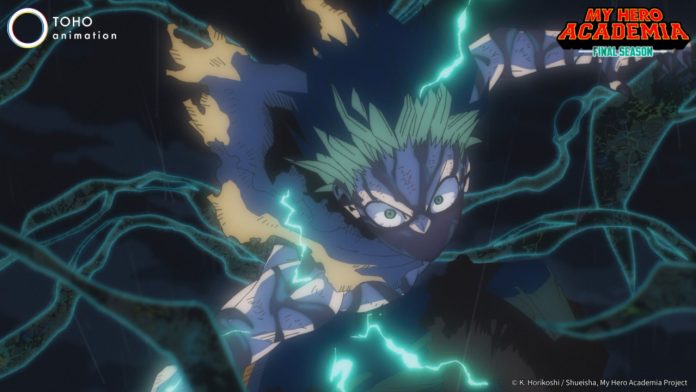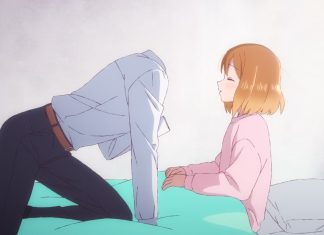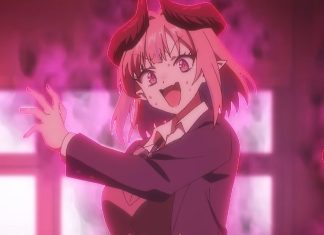As My Hero Academia barrels toward its emotional sunset in Season 8, Episode 6 drops like a emotional haymaker, blending brutal fisticuffs with soul-baring introspection. Airing fresh on November 8, 2025, this 165th overall installment—titled “Wrench It Open, Izuku Midoriya!”—picks up the threads of the Final War arc’s apex, thrusting Deku into a desperate gambit against Tomura Shigaraki. It’s not just a fight; it’s a psychological siege, where our green-haired hero wields empathy as fiercely as One For All’s remnants. If Season 8 has been a slow-burn crescendo of redemption and ruin, this episode turns up the volume, forcing viewers to confront the series’ core question: Can you save someone who’s hell-bent on your destruction? Spoiler: It’s messy, it’s masterful, and it’ll leave you wrecked.
The Battle Unfolds: Gearshift Gambles and Blackwhip Barriers
Right out of the gate, the episode dives back into the maelstrom of Deku vs. Shigaraki, the air thick with the acrid tang of quirk-fueled devastation. Fresh off losing Danger Sense in Episode 5, Deku—battered, bloodied, but unbowed—grapples with a radical pivot: transferring the vestige of Kudo’s Gearshift quirk directly into his arsenal to counter Shigaraki’s escalating horrors. It’s a high-wire act of instinct and ingenuity, showcasing Deku’s evolved battle IQ as he puppeteers his ravaged body with Blackwhip tendrils snaking across his skin like living shadows. These “Blackchain” restraints whip out to shield his allies from Shigaraki’s Decay waves, a visceral sequence where the animation pulses with raw desperation—Deku’s costume in tatters, his breaths ragged, every extension of the quirk a testament to his refusal to break.
Shigaraki, no longer the detached destroyer but a cornered beast, summons a grotesque swarm of hands for defense, his cracked mask slipping to reveal flickers of raw panic. The villain’s counterattacks land like sledgehammers, but Deku flips the script with Smokescreen—not as a mere smokescreen, but a tactical fog to blind and disorient, proving once again that no quirk is “useless” in the right hands. It’s a clever nod to MHA‘s ethos: heroism thrives on adaptation, not just power. As the clash intensifies, Deku enters a “Carnage Mode” hybrid of fury and finesse, his movements a blur of Gearshift-amped precision that carves openings for the unthinkable—reaching into Shigaraki’s fractured psyche.
Interwoven masterfully are cuts to the wider world: civilians huddled in U.A.’s shadow, heroes like Lady Nagant offering terse counsel amid the chaos, and Class 1-A’s raw vulnerability on full display. Kaminari’s breakdown steals breaths—a wide-eyed, tear-streaked moment of doubt that humanizes the electric teen, his voice cracking as he whispers fears for Deku, only for a steely pep talk to pull him back. Eri and Kota’s quiet vigil hits like a gut punch, their wide eyes reflecting the festival memories that once sparked Deku’s unbreakable spirit. Even subtle callbacks, like the reformed slime villain from Episode 1 flickering in the crowd, weave a tapestry of full-circle growth, reminding us how far the “Symbol of Peace” legacy has rippled.
Peeling Back the Trauma: Shigaraki’s Shadowy Reckoning
The episode’s true gut-twist arrives in the vestige realm, where Deku doesn’t just punch—he probes. Channeling his boundless empathy, he extends a hand (metaphorical and literal) to the boy beneath the monster, reflecting on his own journey of seeing “the good in everyone.” Shigaraki’s response? A nightmarish flashback to his father’s abuse, the scenes rendered in stark, shadowy strokes that blur the line between memory and madness. Hands claw from the darkness, a horrifying echo of his quirk’s origins, as the villain retreats into subconscious barricades to block Deku’s intrusion. It’s a cliffhanger that chills: Shigaraki, haunted and hiding, his “incomplete” evolution cracking under the weight of buried pain. This isn’t cartoonish villainy; it’s a raw excavation of generational scars, forcing Shigaraki to confront the humanity he’s long decayed away.
Deku’s monologue seals the emotional core—his voice steady amid the storm, vowing to “wrench open” not just a heart, but a soul. It’s peak MHA philosophy: destruction begets more destruction, but connection? That’s the real quirk that changes everything.
Animation, Score, and That Unyielding Tension
Studio Bones flexes hard here, with sakuga bursts elevating the Blackwhip frenzy and Gearshift dodges into kinetic poetry—fluid lines and dynamic angles that make every impact feel bone-jarring. The intercuts between the solo brawl and global perspectives aren’t just filler; they’re a rhythmic pulse, syncing the fight’s isolation with the world’s collective breath-holding. Yuki Hayashi’s OST? A brooding beast—haunting strings underscoring Deku’s puppet-like maneuvers, swelling to tear-jerking crescendos during Kaminari’s vulnerability and Eri’s reminiscence. One fan nailed it: the faint “strings being pulled” audio cue as Blackwhip activates? Chef’s kiss for immersion.
Critics and viewers alike praise the episode’s tonal tightrope—action that propels, emotion that lingers—earning an 8/10 from FandomWire for its “excellent balance.” Sure, some nitpick the flashback pacing or “limited” animation in quieter beats, but in a finale stretch adapting manga’s chapters 414-ish, it lands as a deliberate simmer before the boil.
Social Media Storm: Tears, Hype, and Hot Takes
X lit up like a One For All flare today, with reactions splitting between outright sobs and measured cheers. “DEKU CARNAGE SCENES WERE PEAK! The music made me tear up—8.5/10,” gushed one user, echoing the OST’s emotional knockout. Kaminari’s arc drew universal love—”His expressions and voice acting coupled with music and action 🔥”—while Eri and Kota’s scene wrecked hearts: “They had to watch Deku fight alone… got me good
Not everyone’s plus ultra: Some decried the “cut-up” fight pacing and heavy flashbacks—”Expected a lot more from 8!”—blaming the manga’s structure but appreciating Bones’ extensions. Doomposting felt “overblown” to others, who hailed the last act’s cuts as “fucking awesome” for amplifying the stakes. Reddit’s discussion thread buzzed with full-circle nods to old faces like Gentle Criminal and Eri, calling it a “masterpiece” that ties the series’ bow. One reactor summed the vibe: “Strong OST placement really brought this desperate feeling… makes the characters connect with Deku.”
Why This Episode Wrenches Us Open
In MHA‘s swan song, Episode 6 isn’t the flashiest fireworks display—it’s the quiet fuse that ignites the powder keg of hope amid horror. Deku’s “wrenching” isn’t about brute force; it’s the series’ thesis distilled: True heroism pries open locked doors with kindness, even when fists fly. As Shigaraki cowers in his shadows and the world watches with bated breath, Horikoshi and Bones remind us why we’ve rooted for this quirkless kid since day one. With the preview teasing even wilder twists, next week’s drop could shatter us—or save us.
Binge it on Crunchyroll (subbed at 5:30 AM EST), dub incoming soon after. Did Deku’s empathy land for you, or was the pacing a buzzkill? Spill in the comments—MHA‘s end demands our voices. Plus ultra, till the very last.
BUMP OF CHICKEN performs the ending theme for the show’s eighth and concluding season. The ending theme is titled “I”.
Crunchyroll streams My Hero Academia season 8 anime worldwide excluding Asia.
The opening theme song “THE REVO” by Porno Graffitti.
RELEASE DATE FOR MY HERO ACADEMIA FINAL SEASON: October 4, 2025
My Hero Academia is a Japanese shonen manga crafted by Kōhei Horikoshi. Launched in Weekly Shōnen Jump on July 7, 2014, and concluding on August 5, 2024, it spans 430 chapters compiled into 42 tankōbon volumes. Set in a society where “Quirks” (superpowers) are widespread, the story centers on Izuku Midoriya, a Quirkless teen with ambitions of heroism. His life changes when All Might, the world’s top hero, recognizes his determination and passes on his Quirk, “One For All.” Midoriya joins U.A. High, an elite academy for aspiring heroes, navigating intense training, rivalries, and battles against villains. The manga blends dynamic action, emotional depth, and influences from Western superhero comics, earning over 100 million copies in circulation by April 2024, including spin-offs, cementing its status as a global phenomenon.
The anime adaptation, produced by Studio Bones, brings Horikoshi’s story to life with vivid animation and a compelling soundtrack. Premiering on April 3, 2016, it closely follows the manga, chronicling Midoriya’s growth at U.A. High and his clashes with villains like the League of Villains. The series spans seven seasons (with an eighth planned for October 2025), covering 158 episodes as of July 2025. Key seasons aired as follows: Season 1 (April–June 2016), Season 2 (April–September 2017), Season 3 (April–September 2018), Season 4 (October 2019–April 2020), Season 5 (March–September 2021), Season 6 (October 2022–March 2023), and Season 7 (May–October 2024). The anime also includes four films—Two Heroes, Heroes Rising, World Heroes’ Mission, and You’re Next—and ten OVAs. It’s lauded for its animation quality, voice acting (Japanese and English), and action, though some critique its pacing.
Kōhei Horikoshi is the manga’s writer and artist, inspired by his earlier works like Oumagadoki Zoo and a 2008 one-shot, My Hero. His love for Western superhero comics and shonen manga shaped the series’ unique style. The anime was helmed by Studio Bones, with Kenji Nagasaki directing, Yōsuke Kuroda scripting, Yoshihiko Umakoshi designing characters, and Yuki Hayashi composing music. Horikoshi contributed to the anime, notably on films and additional scenes.
The series has grown into a vast franchise, including spin-off manga (Smash!!, Vigilantes, Team-Up Missions), light novels, video games, stage plays, and merchandise. A live-action film by Legendary Entertainment is in development. The manga frequently topped The New York Times best-seller list, and the anime has garnered acclaim for its storytelling, art, and cultural nods to superhero comics, making it a cornerstone of modern anime and manga.
ALSO READ: Exploring Studio MAPPA’s Top 15 Anime Series: A Powerhouse of Modern Anime Innovation


